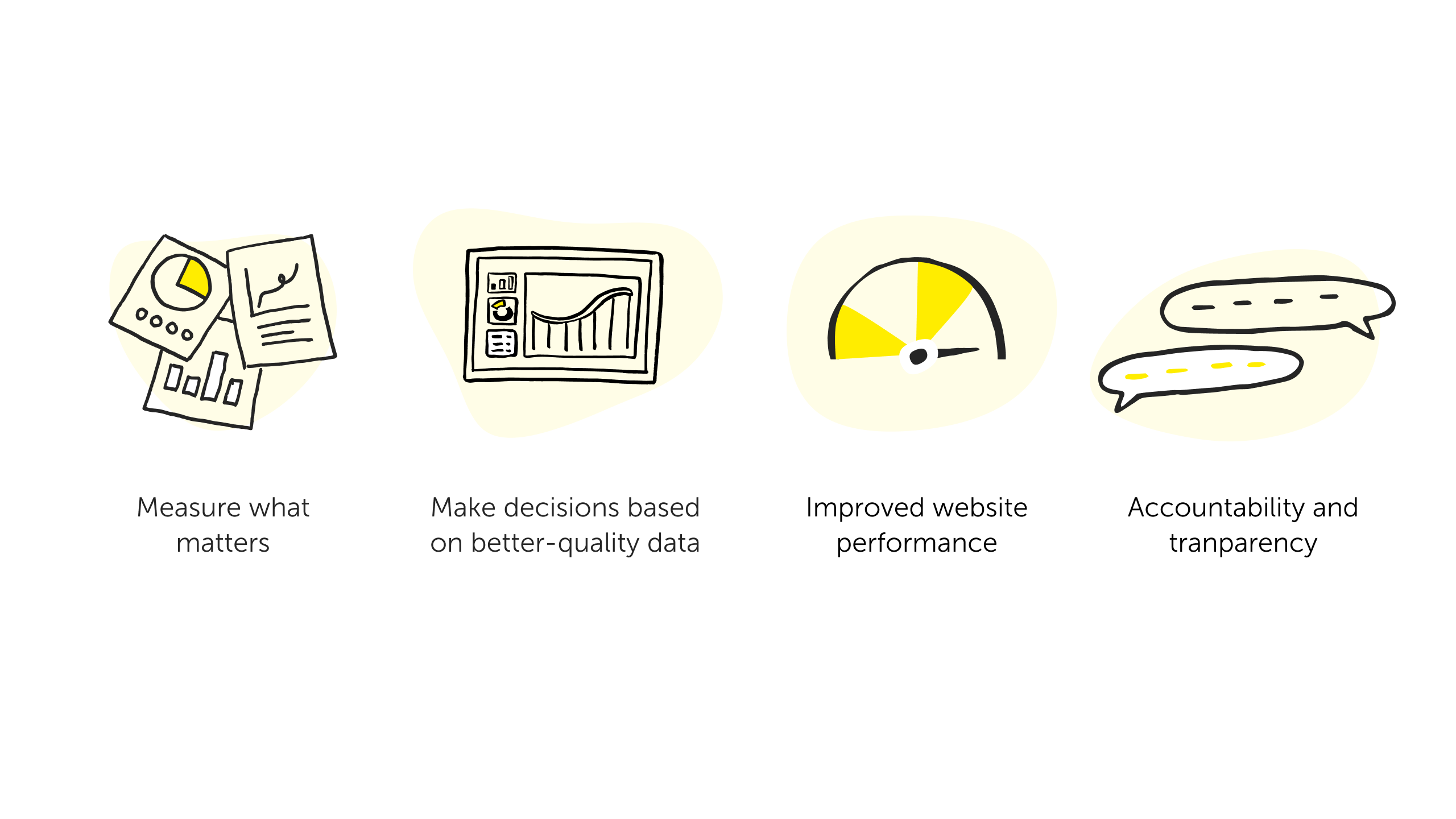
The problem with data is that you can have too much of it. Google tracks hundreds of metrics and dimensions out of the box. It also allows you to build upon that and create your own metrics and dimensions. This results in reports rich in data, but perhaps lacking in meaning.
We are often asked to track every action a user might take on a website. But it leaves us asking, so what?
The key to unlocking the power behind analytics and quantitative data is to give it meaning. While qualitative data reveals deep user insights, you should not ignore the trends within your quantitative data. Problems with websites can often be found within your analytics data long before you do qualitative research.
If you’re looking for help with Google Analytics 4, we’d love to help. Our analytics team offers a range of Google Analytics 4 services to support your business needs.
How to reveal insights in your quantitative data
A Google Analytics measurement plan outlines a website’s:
- goals
- objectives
- key performance indicators (KPIs)
- metrics and data sources needed for analysis.
It provides a clear roadmap for data collection, reporting and analysis, ensuring alignment with business objectives. It helps businesses make informed decisions and improve their digital presence.
However, it is common for businesses to focus on vanity metrics, such as page views, and traffic numbers. While they can be flattering, such metrics don’t always relate to business objectives. For example, a high volume of traffic doesn’t always result in more leads or sales. You need to understand more about the quality of that traffic. By triangulating traffic volumes, engagement and conversions you should be able to understand more about your users.
You may learn that although your social media traffic has a lower volume than other sources, it has a higher conversion rate. Or you might realise that the paid traffic you have invested in is engaging with your content but not converting.

What if my website doesn’t need to generate leads or sales?
It is still important to think about conversions even if your website is content-based. You should have business objectives that you could turn into conversions and KPIs to measure.
These are called tactical conversions. A tactical conversion is an action or user behaviour indicator that shows users are engaging with your website how you want.
Examples include:
- Signing up for a newsletter
- Sharing a piece of content on a social network
- Setting a goal for when users have read more than two pieces of your content.
Why are analytics measurement plans important?
A measurement plan for digital analytics on your website is vital for the following reasons:
Measure what matters
Analytics measurement plans help you clarify your business objectives and align your data collection and analysis efforts with these objectives. This ensures you are measuring what matters most and can make informed decisions based on the data. It helps you focus on the why and prevents you from concentrating on vanity metrics.
Make decisions based on better-quality data
Your analytics measurement plan should outline the data sources and collection methods, and the processes and procedures for ensuring data accuracy and quality. This will help you avoid making decisions with inaccurate or unreliable data.
Improved website performance
You should see an improvement in your website performance because you can make better decisions.
By clearly outlining the roles, responsibilities and processes related to data collection and analysis, your plan should promote accountability and transparency. This means everyone in your organisation is on the same page and working towards the same goal.

What’s in a digital analytics measurement plan?
A plan typically consists of several parts that define the strategy for measuring your website’s effectiveness. Here are the main components of an analytics measurement plan.
Purpose and objectives
This can be a written statement and should outline overall goals and objectives for your website, either as a whole or for an individual campaign. This section helps to define your targets for everyone who reads your plan. It can be as simple or as comprehensive as you need.
Key performance indicators
When defining your KPIs, remember these will be translated into metrics. You will then use these metrics to measure progress towards the goals and objectives as outlined in the previous step. This section defines the specific KPIs that you will track and measure.
Examples include:
- Website traffic
- Conversion rates
- Customer retention rates
Metrics and data sources
This is where you design your data collection framework which developers and analytics specialists can implement. It should include information on the types of data you want to collect, such as web analytics data, social media metrics, or customer survey data.
If you are using Google Analytics 4, you could also include the data model used to collect the data. You also need to define the data sources used to collect the data, such as Google Analytics, Facebook Insights, or CRM systems.
Data collection methods
The data collection methods section outlines how data will be collected and processed. Include information on the tools and technologies, and the people, processes and procedures for ensuring data accuracy and quality.
Reporting and analysis
Include a section that outlines how data will be analysed and reported. It should also capture the reporting frequency and the format of reports, such as exploration reports in Google Analytics 4, dashboards, or spreadsheets. It is common to need a varying style of reports for different departments or people across your business. Users of these reports should be able to understand and identify the successes of your campaigns, as well as the areas for improvement.
By defining these key components, your analytics measurement plan will provide a clear roadmap for measuring your website data against business objectives. It helps focus your efforts on important data points, ensure data accuracy and quality, and make data-informed decisions to improve performance and achieve business goals.

Example analytics measurement plan
Purpose and objective
Purpose: To measure and analyse website data to improve the user experience, increase website traffic and boost sales.
Objectives:
- Increase website traffic by 20% within the next 6 months
- Increase conversion rate by 10% within the next 6 months
- Reduce bounce rate by 5% within the next 6 months
KPIs:
- Website traffic: total website users, new vs returning users, traffic sources (organic, paid, direct, referral)
- Conversion rate: total sales, conversion rate by traffic source, average order value, abandoned cart rate
- User engagement: time on site, pages per session, engagement rate
Metrics and data sources
Metrics:
- Website traffic: Google Analytics
- Sales data: e-commerce platform
- User feedback: customer surveys
Data sources:
- Website traffic: Google Analytics tracking code installed on the website
- Sales data: integration between e-commerce platform and analytics tool
- User feedback: email surveys sent to customers who have made a purchase
Data collection methods:
- Google Analytics: install tracking code on the website, configure goals and events and set up e-commerce tracking
- E-commerce platform: set up integration with Google Analytics or other analytics tools, configure tracking for sales, transactions and revenue
- Customer surveys: develop survey questions, send email surveys to customers, and collect and measure responses
Reporting and analysis
- Reporting frequency: monthly reports, quarterly reviews and annual summaries
- Reporting format: dashboard with key metrics and KPIs, scorecard with progress towards objectives and spreadsheets with detailed data
- Analysis: regular analysis of data to identify trends, patterns, and opportunities for improvement. We will use A/B testing and other methods to optimise website performance and user experience
When creating your analytics measurement plan, we recommend using a workshop format between your strategy, marketing, analytics, and developer teams. These people or teams will support creative discussion about how you can measure user behaviour or interaction. You will also foster a shared understanding, creating a better environment for problem-solving.
Can we help you?
If you are struggling with unpicking your tracking, our talented analytics specialists at Nomensa would love to help! They are experienced in supporting large, medium and enterprise businesses to quantify experiences across their digital estate.
We drive commercial value for our clients by creating experiences that engage and delight the people they touch.
Email us:
hello@nomensa.com
Call us:
+44 (0) 117 929 7333




